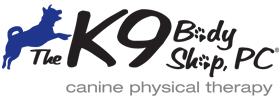Publications
The Wolfe Kinetic Technique
by Tammy Wolfe, DPT, PT, CCRP, GCFP
Much like people, canines are born with certain predispositions, not only in character and personality, but also in the way they move. Various breeds carry themselves and move completely differently than other breeds, and within each breed there is also a wide variance of movement patterns and habits. The posture and movement patterns of each dog is as unique as each of their intricate personalities. As an animal physical therapist, this is both challenging and exciting as we rehabilitate each dog and try to return them to their unique movement patterns following injury or illness.
Because canines and humans are very similar biomechanically, and because there has been infinitely more research done with humans in the field of physical therapy, animal physical therapy treatments have been built upon what is successful in the human physical therapy field. We apply many of the same concepts and treatments, such as ultrasound, electrical stimulation, infrared, dry needling, laser, exercises, taping, orthotics, hydrotherapy and manual therapy. Research has repeatedly shown that the addition of manual therapy to a physical therapy program vastly improves the effectiveness of treatment in the human world. We have found that the results are similar, and can be even more dramatic in the animal world.
The Wolfe Kinetic Technique is a healing modality I developed over the past 15 years while working with animals. It has proven to be extremely effective in returning animals to their previous level of function. Because it is a method of neuromuscular re-education, it also helps prevent re-injury or secondary injuries from occurring once the animal has resumed normal activities. It has also been amazingly successful in enabling geriatric animals to return to more normal and less painful movement patterns and live more comfortably as they age.
This practice is based on concepts from a variety of manual therapy techniques taught in traditional physical therapy, as well as my training and experience in the Feldenkrais Method, which is a holistic approach to movement. The goal with the Wolfe Kinetic Technique is to re-educate the neuromuscular system manually. This allows the animal to re-learn how to move normally in a way that suits his unique styles of movement and posturing. So how is this done?
When we evaluate a patient, we analyze how the animal moves, not only in walking, but how he changes positions, shifts weight through the body and paws, and postures in various positions. We compare those movement patterns with the various types of movement patterns considered “normal” for the age and breed of that animal. We note how that specific animal moves in normal ways and what parts of their movements are not normal, diminished or completely absent.
As with people, when animals are in pain, whether from injury, overuse or arthritic aging, they begin moving differently in an effort to compensate for the changes in their body. Many times, even after an injury has healed, the abnormal movement patterns remain as they have become “normal” for that animal. They need to be shown how to change their movement patterns back to normal. The process of movements becoming habitual, either in a debilitating way or in a rehabilitating way, is called neuroplasticity. Neuroplasticity involves changing and building nervous pathways and is constantly taking place within each of us. The more we do something the same way, the stronger the neuropathways become. Less-used pathways, likewise, become weaker. With the proper type and amount of input, the neuropathways and movement patterns can be changed.
This is where the Wolfe Kinetic Technique comes in. The work involved is a very gentle and subtle manual technique that feels good to the patient. Multiple studies have shown that learning—of any type—is most effective when the experience is positive. When the body is learning or re-learning to do something differently from what has become habitual, it is important that it feel good to maximize the learning process.
Our neuromuscular system wants to continue moving in ways that feel good and are pain-free or, as with chronic disease or conditions, are the least painful ways to move. We show the patient with our hands what the easiest movement patterns are for them, given their natural tendencies. The focus of the technique is to show each animal how they can move in a more comfortable way, rather than showing them how they can’t move easily, as do some forms of manual therapy which can cause discomfort or pain.
Specific joints and tissues have small micro-movements that must be present and performed well before the entire body can perform well. The Wolfe Kinetic Technique, when performed by a specially trained professional, begins with very gentle manual movements working with one joint or tissue at a time. It then expands the normal movement of one area to a larger and larger area, involving more and more of the body until the entire movement pattern becomes normal (or as normal as possible) throughout the body.
This technique has been successful in treating thousands of canines, felines and exotic animals including komodo dragons, camels, sea lions and antelope. It is equally effective with people. I am currently developing classes to teach the Wolf Kinetic Technique to physical therapists and other professionals working in the animal rehabilitation field. But for now, this highly effective method and specialized training can only be found at The K9 Body Shop at 12500 West 58th Avenue in Arvada.
This article appeared in the Feb/March 2018 issue of Mile High Dog magazine.
